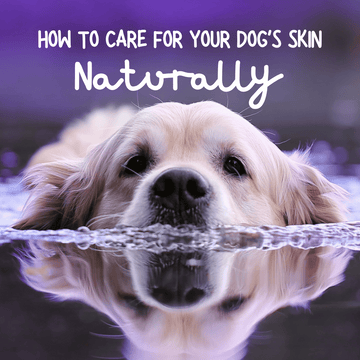By Sarah Griffiths, DCH
If you follow me on my other channel @theanimalsynergist, you'll know that I'm always going on about gut health, skin health and the microbiome. The reason for this is that the microbiome plays a huge part in keeping your dog's skin and coat healthy. Skin allergies are particularly common in modern dogs and science is showing that dogs that develop atopic dermatitis (aka skin allergies) have 5 times less gut microbiome diversity compared to those of non-allergic dogs. (1) This study is paramount in understanding that these little bugs strengthen and nourish the skin.
Today's article includes my top 6 tips for keeping your pet's skin as healthy as possible.
1. Use Gentle, Plant-Based Shampoos
Using a castle or coconut-based shampoo with no synthetic preservatives or fragrances will help support the skin microbiome. These gentle soaps will remove debris and dirt without stripping the important oils out of the skin and coat. That's where those little bugs live so you want to keep that oil barrier intact!
Aromatherapy can also be a supportive addition to the shampoo routine depending on the animal. Aromatherapy oils should be therapeutic-grade or higher.
Bathe your dog minimally, meaning only when needed and not on a particular schedule. If you are bathing the skin too often it can disturb the oil barrier, even if it's really gentle soap.
2. Feed Your Dog A Fresh, Species-Appropriate Diet
We really are what we eat and that's very true when it comes to the microbiome. The gut flora will mimic the diet of the animal and so it's important to provide diverse fresh food options to ensure the gut is as healthy as possible. Science reveals that microbiome diversity is an important part of maintaining biological resilience. The gut microbiome feeds into all other microbiome systems in the body, including the skin - that's why it's so important to feed a healthy diet.
If you'd like to learn more about feeding a well-balanced fresh food diet to your dog, check out my other platform, The Animal Synergist.
3. Avoid Anti-Microbials
Whenever possible, avoid "anti-bacterial" products including shampoos and ear cleaners. Also avoid internal antibiotics unless it's an absolute emergency. A scenario I commonly see is animals have a minor would or a bout of diarrhea and then get a round of antibiotics followed by a flare up of skin allergies. The two incidents aren't separate! Unfortunately, animals can get secondary bacterial infections on the skin ones it's inflamed (eg. yeast and staphylococcus) which are then further treated with more antibiotics and more damage to the gut. It's a very vicious cycle that I see often. To avoid this scenario, consider avoiding anti-materials and internal antibiotics unless you really think it's an emergency. There are so many other options to try before hitting the hard stuff.
Aromatherapy and organically-based skin and ear products are a much better bet for regular hygiene.
4. Try Calendula Herbal Products for the Itch
If your pet has a minor wound that's healing or a hotspot, try herbal solutions first. Herbs are the traditional way of helping the skin heal and they can be very powerful and fast-acting. Calendula (marigold) is particularly useful in herbal tincture, cream and salve form. Tinctures can be used to b bath or compress the area for immediate itch relief. Open areas of skin should be kept clean, dry and open to oxygen until they have formed a scab. Then, to aid in skin granulation, calendula can take it from there. It can also keep the area from becoming overly itchy so your dog doesn't keep re-opening the area.
Steroid and antibiotic creams can create the same hamster wheel scenario with your dog's skin by suppressing the symptoms instead of dealing with the deeper issue.
Calendula tincture rinse: Use 15-20 drops of full strength calendula herbal tincture mixed with 1/4 cup of warm water. Bathe or compress the area as long as your dog will let you and then let it air dry. Once it's healed, you can apply a calendula-based salve or cream to aid in the healing process and reduce itching.
If your pet is suffering from chronic allergies or hotspots: If your pet is dealing with chronic skin issues, you definitely need to investigate their internal health. Remember that the skin is a mirror of the internal processes of the immune system. Consult with your vet and/or an integrative practitioner to resolve the deeper issue.
5. Brushing the Coat Does More than Just Make Your Dog Look Pretty!
Regular coat brushing is a great way to oxygenate the skin, another plus for the skin microbiome! This promotes aerobic bacteria (the healthy bugs) on your dog's skin barrier. Anaerobic bacteria (the kind that favours low-oxygen environments), in large numbers, can cause infections on the skin. Brushing and clearing mats is a great way to help the skin stay aerated and healthy.
6. Avoid Flea and Tick Medications
Avoid these unless you have an infestation of fleas or live in a very tick-dense environment. Conventional flea treatments are toxic when used regularly and can also disturb the gut and skin microbiome too. For more on this, check out my blog, The Dangerous Reality of Flea and Tick Medications.
For regular prevention and deterrence of fleas and ticks, use aromatherapy and plant extracts instead. Health Canada recognizes the following aromatherapy oils as flea and tick-repellants:
-eucalyptus
-citrus (lemon, bergamot, orange)
-geranium
-camphor oils (rosemary, pine, cedar wood, etc.)
-neem oil
I hope this article helps you put together a healthy skin-care toolbox!
References:
1. Animals: Comparison of the Gut Microbiome Between Atopic and Healthy Dogs - Preliminary Data, 2022


